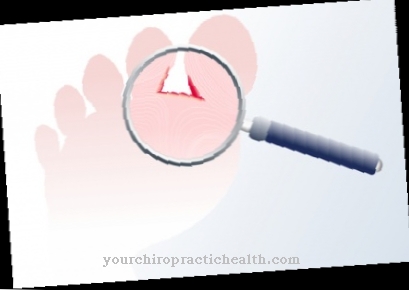At Azlocillin it is a subgroup of the acylaminopenicillins. These are certain beta-lactam antibiotics that are particularly effective against gram-negative pathogens. Azlocillin is administered parenterally, which is typical for representatives of his group. The medicinal substance is used to fight various infectious diseases.
What is azlocillin?
Along with apalcillin, mezlocillin and piperacillin, azlocillin is one of the acylaminopenicillins. This is a group of broad-spectrum antibiotics that are assigned to the penicillins and are based on the starting substance 6-aminopenicillanic acid. The group of acylaminopenicillins has a beta-lactam ring in its molecular structure, which is why representatives of the group are also referred to as betalacam antibiotics.
Azlocillin has a wide spectrum of activity, which is typical for representatives of its class of active ingredients. However, it is primarily used to combat gram-negative bacteria. In human medicine, biology and pharmacology, bacteria and pathogens that turn red when a differential staining process is carried out under the microscope are referred to as gram-negative. This differentiates them from so-called gram-positive pathogens, which turn blue when the procedure is carried out.
The most important pathogens against which azlocillin can be used include the bacteria of the Proteus and Pseudomonas types. a. Can cause respiratory diseases. Proteus pathogens are intestinal bacteria that can be found ubiquitously in nature. Pseudomonads, on the other hand, are described as aerobic bacteria that actively move and occur primarily in bodies of water and on plants.
The molecular formula of azlocillin is C 20 - H 23 - N 5 - O 6 - S. This corresponds to a moral mass (molecular weight) of approx. 461.49 g / mol. In human medicine, it is administered parenterally, i.e. bypassing the intestine.
Pharmacological effect on the body and organs
The pharmacological effect of azlocillin corresponds to the typical characteristics of a beta-lactam antibiotic. The drug attacks the metabolism of the infectious gram-negative bacteria immediately after ingestion. Azlocillin penetrates inside and blocks the essential enzyme D-alanine transpeptidase. As a result, the pathogenic bacteria are no longer able to renew their cell wall independently. The reproduction is stopped and the bacteria eventually die.
The mechanism of action of azlocillin can thus be described as bactericidal. Excretion takes place renally, i.e. mainly via the kidneys.
Medical application & use for treatment & prevention
The bactericidal active ingredient azlocillin is primarily used to combat gram-negative pathogens such as Pseudomonas aeruginosa, enterococci or Proteus. Accordingly, azlocillin is used to fight infectious diseases. Typical areas of application include respiratory diseases and infections of the urinary or abdominal cavity.
Although azlocillin is mainly used against gram-negative bacteria, it can also be used to kill gram-positive pathogens. In the literature, however, the effectiveness against gram-positive bacteria is described as significantly lower, so that other active ingredients are preferred for combating gram-negative pathogens.
Since azlocillin is less widespread than other representatives of its class of active ingredients, it can be used for the treatment of hospital germs. In the case of severe infections, a combination with other drugs may also be indicated.
Azlocillin is typically administered parenterally, i.e. past the intestine. This is because the antibiotic is neither beta-lactamase nor acid-stable. The drug enters the bloodstream immediately through an injection, which significantly increases the onset of its effects.
Risks & side effects
You may also experience undesirable side effects after taking azlocillin.However, this is not mandatory. The majority of the income is generated free of undesirable effects.
Before using it for the first time, it must always be checked whether there is any known intolerance to penicillin or related drugs. Because there is a contraindication in the case of intolerance or allergies. From a medical point of view, it is sensible to stop taking it because it is associated with high risks. This also applies to cross-allergies with other beta-lactam antibiotics.
The most common side effects that may occur after taking azlocillin include skin reactions (e.g. itching, redness, swelling or rashes), fever, or headache. In addition, inflammation of the kidneys, the development of anemia and vascular inflammation are also conceivable. However, these side effects are rare.
Extreme caution should be exercised when using azlocillin during pregnancy and breastfeeding. An extensive risk-opportunity analysis must always be carried out. Obtaining several medical opinions can also be advisable. The same applies to people who suffer from kidney weakness, since the breakdown of the active ingredient mainly takes place renally.



























